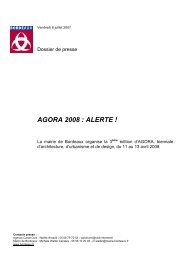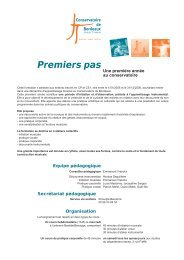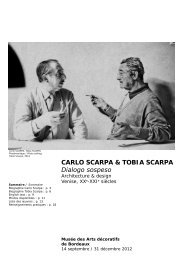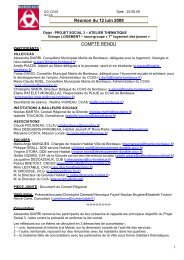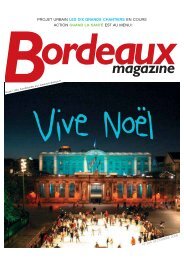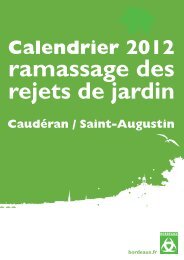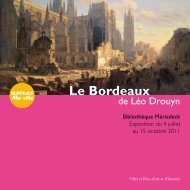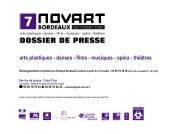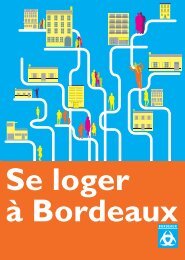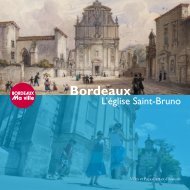Bordeaux Délices - Dossier spécial Jaume Plensa à Bordeaux
Bordeaux Délices - Dossier spécial Jaume Plensa à Bordeaux
Bordeaux Délices - Dossier spécial Jaume Plensa à Bordeaux
You also want an ePaper? Increase the reach of your titles
YUMPU automatically turns print PDFs into web optimized ePapers that Google loves.
<strong>Bordeaux</strong><br />
<strong>Dossier</strong> <strong>spécial</strong><br />
<strong>Délices</strong><br />
<strong>Jaume</strong> <strong>Plensa</strong><br />
<strong>à</strong> <strong>Bordeaux</strong><br />
bordeaux.fr<br />
2d.bordeaux.fr/298<br />
House of Knowledge, 2008. Jonty Wilde © Yorkshire Sculpture Park
Un catalan universel<br />
<strong>Jaume</strong> <strong>Plensa</strong> <strong>à</strong> <strong>Bordeaux</strong>, © Thomas Sanson/Mairie de <strong>Bordeaux</strong><br />
Né en 1955 <strong>à</strong> Barcelone - berceau d’une longue<br />
lignée catalane ayant livré au monde des artistes<br />
de la veine de Gargallo, Miró, Tapiès ou Barceló<br />
- <strong>Jaume</strong> <strong>Plensa</strong> s’imagine tout d’abord... médecin.<br />
Mais c’est finalement <strong>à</strong> travers la sculpture que sa<br />
relation au corps humain prendra forme.<br />
<strong>Plensa</strong> grandit entouré de livres. Mais, nourri de<br />
grands auteurs - William Blake, Shakespeare,<br />
Goethe, Baudelaire... - et d’une solide culture musicale,<br />
c’est encore <strong>à</strong> travers la sculpture qu’il maniera<br />
finalement les lettres et les notes de musique,<br />
ciselées dans l’acier et assemblées en dentelle aérienne<br />
pour façonner des silhouettes tout <strong>à</strong> la fois<br />
monumentales et vaporeuses. « J'ai toujours été<br />
passionné non seulement par les mots, mais par<br />
la fonction biologique des lettres. Seules, elles ne<br />
sont rien, mais ensemble elles forment des mots,<br />
qui ensemble, forment des textes. Une belle métaphore<br />
de la vie et de l’humanité».<br />
Formé <strong>à</strong> la Llotja de Barcelone, <strong>à</strong> la fondation<br />
Henry Moore au Royaume-Uni et <strong>à</strong> l’atelier Calder<br />
<strong>à</strong> Saché, <strong>Plensa</strong> expose pour la première fois en<br />
1980, dans sa ville natale. Ses travaux mêlent alors<br />
le bronze, la fonte et le fer forgé - ses matériaux privilégiés<br />
- <strong>à</strong> divers objets de récupération. Une série<br />
de grands formats en fonte le signale sur la scène<br />
internationale dès le milieu des années 80, tandis<br />
que l’artiste s’éloigne peu <strong>à</strong> peu de la figuration en<br />
concentrant son travail sur les interactions entre le<br />
fer et la lumière, et introduit dans ses créations des<br />
textes poétiques ou de simples mots en relief.<br />
Dès lors, naviguant entre figuratif et abstrait, <strong>Plensa</strong><br />
ne cessera de jouer avec la transparence, ajoutant<br />
<strong>à</strong> sa palette de sculpteur des matériaux translucides<br />
tels que la résine, l’albâtre, ou le verre fondu,<br />
mais aussi de savants dispositifs technologiques -<br />
ainsi sa légendaire Crown Fountain implantée en<br />
2004 dans le Millennium Park <strong>à</strong> Chicago, où défilent<br />
toutes les 4 minutes sur un écran LED inséré<br />
dans une tour en verre de 15 mètres de haut, les<br />
clichés numériques de 1000 visages issus de la<br />
population locale.<br />
Cette exploration du portrait encourage l’artiste <strong>à</strong><br />
creuser l’un des grands thèmes de l’histoire de la<br />
sculpture : la figure sculptée. Les siennes prennent<br />
la forme de têtes géantes, méditatives - maillages<br />
d’acier inoxydable ou monochromes blancs - qu’il<br />
livre <strong>à</strong> l’espace public, son terrain d’exposition favori.<br />
Parmi elles, Dream, dans la ville minière de<br />
St. Helens en Angleterre (2009), Echo, au Madison<br />
Square Park de New York (2011), ou encore Awilda,<br />
émergeant des eaux de la baie de Guanabara<br />
<strong>à</strong> Rio de Janeiro (2012).<br />
Si Barcelone reste son port d’attache - <strong>Plensa</strong> y a<br />
ancré son atelier, où une armada d’assistants, fondeurs,<br />
et ingénieurs l’épaulent exclusivement dans<br />
sa tâche - , la présence internationale de l’artiste<br />
s’est imposée aux quatre coins du monde, en particulier<br />
<strong>à</strong> l’occasion de commandes publiques.<br />
Son tout dernier « autoportrait», réalisé <strong>spécial</strong>ement<br />
pour l’exposition de <strong>Bordeaux</strong>, représente<br />
l’artiste... englobé dans une mappemonde.<br />
An International Catalan<br />
Born in 1955 in Barcelona – the birthplace of a long line<br />
of Catalan artists, such as Gargallo, Miró, Tapiès and Barceló<br />
- <strong>Jaume</strong> <strong>Plensa</strong> initially wanted to be… a doctor. But<br />
in the end, it was through sculpture that his relationship<br />
with the human body would develop.<br />
<strong>Plensa</strong> grew up surrounded by books. Yet, although<br />
reared on great authors - William Blake, Shakespeare,<br />
Goethe, Baudelaire, etc. - and a strong musical culture, it<br />
was still through sculpture that he would finally wield letters<br />
and musical notes, carved into the steel and assembled<br />
into a kind of aerial lace, to create both monumental<br />
and diaphanous silhouettes. “I’ve always been passionate<br />
not just about words, but about the biological function of<br />
letters. Alone, they mean nothing, but together they form<br />
words, which together form texts. A beautiful metaphor for<br />
life and humanity.”<br />
<strong>Plensa</strong> trained at the Llotja in Barcelona, the Henry<br />
Moore Foundation in the United Kingdom and at the<br />
Atelier Calder in Saché, France; he exhibited for the<br />
first time in 1980 in his hometown. His works combine<br />
bronze, cast iron and wrought iron – his preferred materials<br />
– taken from various recovered objects. A series<br />
of large-scale works in cast iron brought him onto the<br />
international stage in the middle of the 1980s, when the<br />
artist gradually distanced himself from figurative art, focusing<br />
on the interactions between iron and light, and<br />
introduced into his creations poetic texts or simple words<br />
in relief.<br />
Subsequently, navigating between the figurative and<br />
the abstract, <strong>Plensa</strong> continued to play with transparency,<br />
adding to his sculptor’s palette translucent materials<br />
such as resin, alabaster and molten glass, as well as<br />
expert technological methods – producing, for example,<br />
his legendary Crown Fountain, installed in the Millennium<br />
Park in Chicago in 2004, where digital images<br />
of 1000 faces from the local population scroll every 4<br />
minutes on a LED screen inserted into a 15-metre high<br />
glass tower.<br />
This exploration of the portrait has encouraged the artist<br />
to look into one of the great themes in the history of<br />
sculpture: the sculpted figure. His figures take the form<br />
of meditative giant heads – meshes of stainless steel or<br />
white monochrome –, which he cedes to the public space,<br />
his preferred exhibition site. They include: Dream, in the<br />
mining town of St. Helens in England (2009); Echo, in<br />
Madison Square Park in New York (2011); and Awilda,<br />
emerging from the waters of Guanabara Bay in Rio de<br />
Janeiro (2012).<br />
Although Barcelona remains his home port – where <strong>Plensa</strong><br />
has established his studio, in which an army of assistants,<br />
smelters and engineers assist him exclusively in<br />
his work -, the artist’s international presence has reached<br />
the four corners of the globe, particularly thanks to public<br />
commissions.<br />
His latest “self-portrait”, created especially for the exhibition<br />
in <strong>Bordeaux</strong>, depicts the artist... incorporated within a<br />
map of the world.<br />
<strong>Dossier</strong> <strong>spécial</strong> <strong>Jaume</strong> <strong>Plensa</strong> <strong>à</strong> <strong>Bordeaux</strong>
<strong>Plensa</strong> & <strong>Bordeaux</strong> :<br />
rencontre sur fond d’humanisme<br />
A <strong>Bordeaux</strong>, qu'il découvre en février dernier <strong>à</strong> l’occasion<br />
d’un premier repérage en vue de l’exposition,<br />
<strong>Jaume</strong> <strong>Plensa</strong> a senti quelque chose lui taper doucement<br />
sur l’épaule : l’âme d’une ville «dont je ne<br />
soupçonnais pas l’harmonie», et «qui cherchait <strong>à</strong> me<br />
raconter son histoire». <strong>Bordeaux</strong> est bien tombée :<br />
<strong>Plensa</strong> a l’oreille et le coeur sensibles. Entre<br />
l’homme de lettres et de culture, et la ville des Lumières,<br />
la rencontre, sur fond d’humanisme, semblait<br />
toute désignée.<br />
Car pour l’artiste catalan, c’est avant tout de cela<br />
qu’il s’agit : d’un échange. « Pour moi, exposer<br />
dans une ville, ce n’est pas déposer ses oeuvres<br />
dans l’espace public... et hop le tour est joué ! Non,<br />
c’est une empreinte <strong>à</strong> double-sens, qui va provoquer<br />
chez moi un sursaut, ouvrir un nouveau chemin<br />
dans mon oeuvre ». De cette inspiration singulière<br />
«qui se mêle mystérieusement <strong>à</strong> celle qui<br />
était déj<strong>à</strong> en cours», <strong>Plensa</strong> a extrait trois oeuvres<br />
spécifiquement créées pour l’événement bordelais,<br />
et pour lesquelles il a décidé de revenir <strong>à</strong> la fonte<br />
de ses débuts : deux figures féminines hautes de<br />
7 mètres, Paula et Sanna, implantées dans deux<br />
sites patrimoniaux emblématiques, place Pey-Berland<br />
et Place de la Comédie, ainsi qu’une sculpture<br />
Self-portrait installée place Camille Jullian. Une<br />
exposition dans l’exposition, un geste artistique<br />
<strong>spécial</strong>ement dévolu <strong>à</strong> la ville.<br />
Lors de ses visites de reconnaissance, <strong>Plensa</strong> a,<br />
comme <strong>à</strong> son habitude «respiré la ville», arpentée<br />
plusieurs fois <strong>à</strong> pied. Tout au long de ce circuit, il a<br />
déterminé le meilleur emplacement pour chacune<br />
de ses sculptures : «l<strong>à</strong> où elles pourront le mieux<br />
engager un dialogue avec la population». Souvent<br />
de petites places, qui l’ont ému par leur chaleur,<br />
leur caractère intime, leur taille humaine : «j’ai privilégié<br />
les lieux de vie quotidiens, de passage, l<strong>à</strong> où<br />
la population se croise, l<strong>à</strong> où les habitants, sur le<br />
trajet du travail ou des courses, ne s’attendent pas<br />
nécessairement <strong>à</strong> voir surgir de l’art contemporain.<br />
Peut-être même l<strong>à</strong> où les touristes ou les habitants<br />
d’autres quartiers ne s’aventurent pas nécessairement....Je<br />
vais leur faire découvrir la ville ! ».<br />
<strong>Plensa</strong> & <strong>Bordeaux</strong> :<br />
A Humanistic Encounter<br />
In <strong>Bordeaux</strong>, on the occasion of a preliminary visit for the<br />
exhibition last February, <strong>Jaume</strong> <strong>Plensa</strong> felt something<br />
tap him gently on the shoulder: the soul of a city “whose<br />
harmony I did not suspect”, and “which sought to tell me<br />
its story”. <strong>Bordeaux</strong> was lucky: <strong>Plensa</strong> has a sensitive<br />
ear and a compassionate heart. A humanistic encounter<br />
between the man of culture and letters and the city of<br />
lights seemed completely natural.<br />
For the Catalan artist, that is above all what it is about:<br />
an exchange. “For me, exhibiting in a city is not about<br />
placing your works in a public space… and there you<br />
go, it’s done! No, it’s a two-way impression, which<br />
provides me with an impetus, opens a new path in my<br />
work.” From this unique inspiration “which mysteriously<br />
merges with that which was already developing,” <strong>Plensa</strong><br />
has extracted three works specifically designed for<br />
the <strong>Bordeaux</strong> event, and for which he chose to return<br />
to the cast iron of his early works. Two 7-metre tall<br />
female figures, Paula and Sanna, placed in two emblematic<br />
heritage sites, Place Pey Berland and Place de la<br />
Comédie, as well as a self-portrait sculpture installed in<br />
Place Camille Jullian. An exhibition within an exhibition,<br />
an artistic gesture granted specifically to the city.<br />
During his advance site visits, <strong>Plensa</strong>, as is his habit,<br />
“breathed the city”, surveying it several times on foot.<br />
During his trips, he determined the best location for each<br />
of his sculptures, “where they could best hold a dialogue<br />
with the population.” The sites are often small squares,<br />
the warmth, intimate character and human scale of which<br />
filled him with emotion: “I preferred places which witness<br />
everyday life, where people pass by, where people intersect,<br />
on their journeys to work or the shops, not expecting<br />
necessarily to see a work of contemporary art appear.<br />
Maybe even places where tourists or residents of other<br />
quarters do not necessarily venture… I want to make<br />
them discover the city!”<br />
Mot du maire<br />
Accueillir l’exposition <strong>Jaume</strong> <strong>Plensa</strong> <strong>à</strong> <strong>Bordeaux</strong><br />
est une extraordinaire opportunité pour notre<br />
ville, ses habitants, ses visiteurs. C’est la possibilité<br />
d’un dialogue inédit entre œuvres contemporaines<br />
et espaces patrimoniaux. Des sculptures<br />
conçues pour des lieux emblématiques de notre<br />
cité alternent avec d’autres installées sur des<br />
places telles des écrins qu’elles transfigurent..<br />
C’est un nouveau regard auquel nous invite le<br />
geste artistique de <strong>Jaume</strong> <strong>Plensa</strong> qui puise dans<br />
la poésie et la littérature la force d’une universalité<br />
qu’il façonne, de manière singulière, afin que<br />
chacun de nous puisse s’interroger, s’émouvoir<br />
et, pour peu qu’il en prenne le temps, se laisse<br />
emporter sur les chemins de l’imaginaire.<br />
Ces hautes figures silencieuses vont nous accompagner<br />
le temps d’un été et nous guider sur de nouveaux<br />
chemins de ville. Une rencontre inoubliable.<br />
Welcoming the exhibition from the artist <strong>Jaume</strong> <strong>Plensa</strong><br />
in <strong>Bordeaux</strong> is an extraordinary opportunity for our city,<br />
its inhabitants and its visitors. It opens a new dialog<br />
between contemporary artworks and patrimonial spaces.<br />
Sculptures created for symbolic places of our city alternate<br />
with others settled on places they transfigure. The<br />
artistic gesture of <strong>Jaume</strong> <strong>Plensa</strong> invites us to take a new<br />
look ; he finds in poetry and literature the strength of a<br />
universality which he shapes, in a singular way, so that<br />
each of us can wonder, be moved, and if time is taken,<br />
let himself take on new ways of imagination.<br />
These high silent characters will accompany us for the<br />
summer and guide us on new city paths. An unforgettable<br />
meeting.<br />
Alain Juppé<br />
Ancien premier Ministre<br />
Maire de <strong>Bordeaux</strong><br />
Premier vice-président de la CUB<br />
Former Prime Minister<br />
Mayor of <strong>Bordeaux</strong><br />
First Vice-president of the CUB<br />
THE HEART OF TREES, 2007. Bronze and tree, 7 elements of variable x 66 x 99 cm, View of the exhibition: <strong>Jaume</strong> <strong>Plensa</strong>. Yorkshire Sculpture Park, West Bretton, UK 2011<br />
Photo: Laura Medina © <strong>Plensa</strong> Studio Barcelona<br />
<strong>Jaume</strong> <strong>Plensa</strong> <strong>à</strong> <strong>Bordeaux</strong> <strong>Dossier</strong> <strong>spécial</strong>
Sculpture Monumentale<br />
espace public<br />
House of Knowledge, 2008 Jonty Wilde © Yorkshire Sculpture Park<br />
Faire descendre l’art dans la rue<br />
<strong>Plensa</strong> a <strong>à</strong> son actif près d’une quarantaine d’installations<br />
dans des espaces publics, <strong>à</strong> titre temporaire<br />
ou pérenne, en divers endroits de la planète.<br />
<strong>Bordeaux</strong> représente cependant une première,<br />
jamais aucune ville dans le monde n’ayant accueilli<br />
un si large éventail de son oeuvre - l’événement<br />
étant habituellement circonscrit <strong>à</strong> une seule pièce.<br />
<strong>Plensa</strong> savoure le caractère «authentique» de cette<br />
aventure bordelaise : une exposition sans prétexte,<br />
sans occasion officielle, sans anniversaire <strong>à</strong> célébrer<br />
: «pour l’art, tout simplement».<br />
Faire descendre l’art dans la rue, précise-t-il, représente<br />
<strong>à</strong> la fois un formidable potentiel d’échange,<br />
une véritable responsabilité vis-<strong>à</strong>-vis de la population<br />
et, pour l’artiste, une certaine prise de risque :<br />
«Se lancer au contact de la population est un<br />
exercice passionnant... et délicat. Par définition,<br />
les habitants n’ont pas eux-mêmes décidé d’assister<br />
<strong>à</strong> cette exposition : elle vient <strong>à</strong> eux. Il faut<br />
s’apprivoiser des deux côtés. L’avantage, c’est que<br />
dans la rue, les spectateurs côtoient, touchent, et<br />
s’approprient davantage les oeuvres. Et dans le<br />
même temps, en (s’)exposant <strong>à</strong> ciel ouvert, l’artiste<br />
n’a pas la crédibilité immédiate qu’apporte le fait<br />
d’exposer dans un musée ou une galerie. Le curé<br />
donne généralement la messe dans l’église : l<strong>à</strong> où<br />
le cadre, le contexte, plaident automatiquement<br />
pour lui...»<br />
Déjouer les codes établis<br />
Déjouer les codes établis : une ligne de conduite<br />
chez <strong>Plensa</strong>, qui lui a valu « de nombreuses contestations<br />
de la part de certains critiques d’art». Ses<br />
créations urbaines bouleversent en effet la tradition<br />
de la sculpture commémorative héritée du XIXème<br />
siècle. L<strong>à</strong> où l’on figeait autrefois dans la pierre les<br />
portraits et les gloires de personnalités célèbres, les<br />
visages introspectifs et les silhouettes évaporées<br />
de <strong>Plensa</strong> interpellent, par leur caractère anonyme,<br />
l’universalité de l’humain. À la dimension politique,<br />
illustrative et décorative de la statuaire publique<br />
habituelle, il substitue le mystère, la transparence,<br />
et la poésie, préférant interroger les contours et la<br />
fragilité de l’être.<br />
Témoins silencieux de l’activité urbaine, les sculptures<br />
de <strong>Plensa</strong> célèbrent l’ordinaire...<strong>à</strong> une échelle<br />
monumentale. En dépit de cette stature, leur allure<br />
presque épurée, leur simplicité d’approche, invitent<br />
au contact - puis dans un second temps, au questionnement,<br />
<strong>à</strong> la réflexion. Ainsi, sa mythique Crown<br />
Fountain, installée depuis 2004 au Millennium Park<br />
<strong>à</strong> Chicago, est-elle devenue le point de ralliement<br />
de la population locale, non sans avoir suscité<br />
quelques hésitations. Tout comme le Cloud Gate<br />
- immense «haricot» en acier poli - d’Anish Kapoor,<br />
qui reflète <strong>à</strong> quelques mètres de l<strong>à</strong> le panorama<br />
urbain, «l’art en plein air exerce une force magnétique»,<br />
souligne <strong>Plensa</strong>.<br />
Il y a donc fort <strong>à</strong> parier qu’après le 6 octobre, une fois<br />
retirées du paysage bordelais pour aller reprendre<br />
leur tour du monde, les 11 oeuvres de <strong>Plensa</strong> laisseront<br />
dans le décor et la mémoire locale un vide <strong>à</strong><br />
la mesure de leur présence : monumental.<br />
Social Sculpture,<br />
Public Space<br />
Taking art to the streets<br />
<strong>Plensa</strong> has around forty installations in public spaces,<br />
temporary or permanent, in various locations around the<br />
world. However, <strong>Bordeaux</strong> represents a first; no other city<br />
Eight Poets in Bamberg. City of Bamberg, Germany 2012 © Photo: Michael Aust<br />
in the world has welcomed such a wide range of his work<br />
– it is usually restricted to a single piece.<br />
<strong>Plensa</strong> savours the “authentic” character of this <strong>Bordeaux</strong><br />
adventure: an exhibition without a pretext, without a formal<br />
occasion, without an anniversary to celebrate: “just<br />
for the art itself.”<br />
He believes that taking art to the streets provides great<br />
potential for an exchange, assumes a real sense of responsibility<br />
towards the public, and, for the artist, a certain<br />
element of risk: “Entering into contact with the population<br />
is exciting… and delicate. By definition, the inhabitants<br />
have not themselves decided to attend this exhibition,<br />
it comes to them. Both sides have to be won over. The<br />
advantage is that, in the street, the spectators stand next<br />
to, touch and take over the works. And, at the same time,<br />
by exhibiting (himself) in the open air, the artist does not<br />
have the immediate credibility provided by exhibiting in a<br />
museum or gallery. The priest generally gives a mass in<br />
a church, where the setting and the context automatically<br />
speak for him…”<br />
Circumventing the established<br />
conventions<br />
Circumventing the established conventions: an approach<br />
which has earned <strong>Plensa</strong> “many protests from certain art<br />
critics”. In fact, his urban creations upset the tradition of<br />
commemorative sculpture inherited from the 19th century.<br />
Where portraits and achievements of famous figures were<br />
formerly set in stone, <strong>Plensa</strong>’s introspective faces and<br />
evaporated silhouettes question the universality of the<br />
human being through their anonymous character. Instead<br />
of the political, illustrative and decorative dimension of<br />
traditional public statuary, he substitutes mystery, transparency<br />
and poetry, preferring to examine the contours<br />
and fragility of the being.<br />
Silent witnesses of urban activity, <strong>Plensa</strong>’s sculptures<br />
celebrate the ordinary… on a monumental scale. Despite<br />
their size, their almost purified look and their simplicity of<br />
approach invite contact - and also encourage questioning<br />
and reflection. In this way, his mythical Crown Fountain,<br />
installed in the Millennium Park in Chicago since 2004,<br />
has become the rallying point of the local population, not<br />
without having aroused some hesitation. Just like Cloud<br />
Gate - the huge “bean” in polished steel – by Anish Kapoor,<br />
which reflects the urban panorama several metres<br />
from there, “art in the open air exerts a magnetic force,”<br />
stresses <strong>Plensa</strong>.<br />
There is therefore every chance that after 6 October, once<br />
removed from the <strong>Bordeaux</strong> landscape to depart on their<br />
tour around the world, the 11 works by <strong>Plensa</strong> will leave<br />
behind an emptiness in the environment and in local memory<br />
that is proportional to their presence: monumental.<br />
<strong>Dossier</strong> <strong>spécial</strong> <strong>Jaume</strong> <strong>Plensa</strong> <strong>à</strong> <strong>Bordeaux</strong>
a<br />
Parcours de sculptures en ville / 27 juin - 6 octobre<br />
Open air sculptures around the city / June 27th - October 6th<br />
1 Marianna & Awilda :<br />
Cour de l'Hôtel de ville<br />
2013, Acier inoxydable, 400 x 420 x 300 cm (2)<br />
Collection: Bradley Jacobs, Greenwich, Connecticut,<br />
USA<br />
Les visages des deux jeunes filles Marianna & Awilda<br />
mêlent légèreté, transparence et monumentalité. Réalisées<br />
en un maillage en acier inoxydable, ces deux têtes<br />
entament une conversation silencieuse entre elles mais<br />
aussi avec l’environnement minéral de la cour que l’on<br />
voit <strong>à</strong> travers.<br />
The faces of two young girls, Marianna & Awilda, combine<br />
lightness, transparency and monumentality. Made from a<br />
stainless steel mesh, these two heads engage in a silent<br />
conversation with each other, but also with the mineral<br />
environment of the courtyard that we see through them.<br />
2 Paula : Place Pey-Berland<br />
2013, Fonte de fer, 703 x 98 x 255 cm<br />
Paula est une jeune fille de Barcelone que l’artiste croise<br />
régulièrement <strong>à</strong> côté de son atelier. Les yeux fermés, elle<br />
est plongée dans un état contemplatif et onirique. Modélisée<br />
<strong>à</strong> partir des clichés photographiques, cette œuvre<br />
porte l’aspect délibérément uniformisé des portraits, qui<br />
sont caractéristiques dans l’œuvre de <strong>Plensa</strong>.<br />
Avec le soutien d’Urbi Cité et Cirmad pour la réalisation<br />
du socle.<br />
Paula is a young girl from Barcelona whom the artist regularly<br />
saw near his studio. Her eyes closed, she is immersed in a contemplative<br />
and dreamlike state. Modelled from photographic<br />
images, this work has the deliberately uniform appearance of<br />
portraits, which are characteristic in <strong>Plensa</strong>’s work.<br />
3 Ainsa II : haut du cour de l’Intendance<br />
2013, acier inoxydable et pierre, 315 x 240 x 384 cm<br />
Ainsa est le nom d’un petit village médiéval, situé près<br />
de Huesca dans les Pyrénées aragonais. C’est dans une<br />
carrière de pierre de Huesca que l’artiste sélectionne les<br />
blocs de pierres sur lesquels il fait reposer ces figures<br />
masculines<br />
Ainsa is the name of a small medieval village situated<br />
near Huesca in the Aragon Pyrenees. A quarry in Huesca<br />
provided the blocks of stone on which the artist rests<br />
these masculine figures.<br />
4 Sanna : Place de la comédie<br />
2013, Fonte de fer, 703 x 98 x 255 cm<br />
Sanna, comme Paula (place Pey Berland), appartient <strong>à</strong> une<br />
série de sept figures féminines imaginées dès après la rencontre<br />
préméditée entre l’artiste et la ville. Bien que seules deux<br />
d’entre elles aient pu être fondues et exposées <strong>à</strong> <strong>Bordeaux</strong>,<br />
ces figures représentent un nouveau chemin de réflexion et<br />
d’expérimentation artistique dans l’œuvre de <strong>Plensa</strong>.<br />
Avec le soutien d’Urbi Cité et Cirmad pour la réalisation<br />
du socle.<br />
Sanna, like Paula (Place Pey Berland), belongs to a<br />
series of seven feminine figures envisaged since the<br />
encounter between the artist and the city was planned.<br />
Although only two of them could be cast and exhibited in<br />
<strong>Bordeaux</strong>, these figures represent a new path of reflection<br />
and experimentation in <strong>Plensa</strong>’s work<br />
5 Heart of trees : Jardin Public<br />
2007, Bronze – 7 figures, 99 x 66 x 99 cm<br />
L’œuvre se compose de sept personnages masculins,<br />
assis sur un monticule de terre dont les bras et les<br />
jambes s’enroulent autour d’un arbre vivant et recouverts<br />
de mots. A travers la figure tutélaire de l’arbre, l’artiste<br />
joue sur la métaphore de la communion de l’homme<br />
avec la nature.<br />
The work is composed of seven masculine figures, sitting<br />
on a mound of earth, their arms and legs wrapped around<br />
a living tree and covered in words. Through the protective<br />
figure of the tree, the artist plays on the metaphor of<br />
man’s communion with nature.<br />
6 House of Knowledge : Place de la Bourse<br />
2008, acier inoxydable, 800 x 550 x 530 cm<br />
Composée d’une multitude de lettres soudées, cette<br />
grande forme humaine est comme une invitation permanente<br />
au voyage dans l’espace et dans la sculpture<br />
elle-même.<br />
Avec le soutien d’Urbi Cité et Cirmad pour la réalisation<br />
du socle.<br />
Composed of a multitude of welded letters, this large human<br />
shape is like a permanent invitation to travel into the<br />
space and the sculpture itself.<br />
7 The Poets (Body Soul, Country, Water<br />
Fire) : Esplanade Edmond Géraud<br />
2012, Résine et acier inoxydable, 800 x 152 x 131 cm<br />
The Poets apparaissent comme une suite poétique de La<br />
Llargat Nit, en référence au poème du poète catalan Vicent<br />
Andrés Estelés. Ils se présentent comme des figures<br />
de lumière assis sur des mâts, les yeux fermés et isolés<br />
dans une position accroupie méditative.<br />
Avec le soutien d’Urbi Cité et Cirmad pour la réalisation<br />
du socle.<br />
The Poets appears to be a poetic continuation of La Llargat<br />
Nit, in reference to the poem by Catalan poet Vicent<br />
Andrés Estelés. They are presented as figures of light sitting<br />
on masts, their eyes closed, isolated in a meditative<br />
squatting position<br />
8 Ainsa I : Place Saint Pierre<br />
2013, acier inoxydable et pierre, 320 x 215 x 380 cm<br />
Collection, Washington University in Saint Louis,<br />
Missouri, USA<br />
Ainsa est le nom d’un petit village médiéval, situé près<br />
de Huesca dans les Pyrénées aragonais. C’est dans<br />
une carrière de pierre de Huesca que l’artiste sélectionne<br />
les blocs de pierres sur lesquels il fait reposer<br />
ces figures masculines.<br />
Ainsa is the name of a small medieval village situated<br />
near Huesca in the Aragon Pyrenees. A quarry in Huesca<br />
provided the blocks of stone on which the artist rests<br />
these masculine figures<br />
9 Self-Portrait : place Camille Jullian<br />
2013, acier inoxydable, 350 x 325 x 325 cm<br />
En position méditative, agenouillé <strong>à</strong> l’intérieur d’une<br />
sphère constituée de lettres, de mots, et de signes<br />
divers et variés, <strong>Plensa</strong> se retrouve au cœur d’un système<br />
plus vaste. Cette oeuvre invite la population <strong>à</strong><br />
découvrir l’universalité du langage, la diversité des<br />
cultures tout autant que l’interconnexion entre les<br />
êtres. Avec le soutien d’Urbi Cité et Cirmad pour la<br />
réalisation du socle.<br />
In a meditative position, kneeling inside a sphere<br />
composed of letters, words and various signs, <strong>Plensa</strong><br />
finds himself at the centre of a vast system. This work<br />
invites the public to discover the universality of language,<br />
the diversity of cultures and the interconnection<br />
between beings.<br />
Jardin<br />
Public<br />
L<br />
G a<br />
r o<br />
n n<br />
Place<br />
de la Bourse<br />
e<br />
10 Thoughts : Place Fernand Lafargue<br />
2013, acier inoxydable et pierre, 310 x 200 x 270 cm<br />
Thoughts est constituée de phrases de pensées qui s’entrecroisent<br />
et se chevauchent sur de grands bandeaux en<br />
acier inoxydable.<br />
Elle illustre parfaitement cette recherche de la construction<br />
de la pensée dans l’espace, les croisements de<br />
langues et de langages plastiques et littéraires chers<br />
<strong>à</strong> l’artiste.<br />
Thoughts is made up of phrases of thoughts which interweave<br />
and overlap on great strips of stainless steel.<br />
It perfectly illustrates this exploration of the construction<br />
of thought in the space, the intersections of languages<br />
and the artistic and literary languages valued by the artist.<br />
Mémorial de l'Hôtel de ville, Place Pey-Berland. L’exposition de maquettes et d’éditions originales dans les salons de l’Hôtel<br />
de Ville est l’occasion de découvrir une sélection de grands projets réalisés par <strong>Jaume</strong> <strong>Plensa</strong> <strong>à</strong> travers le monde.<br />
Elles rendent compte des recherches menées par l’artiste sur le corps humain, et plus particulièrement sur la figure humaine, la diversité<br />
des formes et des matériaux qu’ils utilisent. Elles montrent tout autant un renouvellement de la figure sculptée dans l’espace public<br />
qu’une réflexion sur la place de l’homme dans le monde.<br />
The exhibition of models and original editions in the salons of the City Hall is an opportunity to discover a selection of major projects by<br />
<strong>Jaume</strong> <strong>Plensa</strong> around the world.<br />
They reflect the research conducted by the artist about the human body, especially concerning the human figure, the diversity of shapes and<br />
materials they use. They show as much a renewal of the carved figure in the public space as a reflection on the place of man in the world.<br />
11 Silent Music II :<br />
Esplanade Théâtre Casino Barrière<br />
2013, acier inoxydable et pierre, 310 x 230 x 290 cm<br />
Enfant, l’artiste s’installait <strong>à</strong> l’intérieur du piano de son<br />
père pour sentir les vibrations des sons et de son propre<br />
corps. Silent Music II rend compte de cette expérience<br />
sensorielle silencieuse, avec cette figure humaine<br />
constituée de notes de musiques qui, comme les lettres<br />
d’un alphabet, symbolisent l’expression d’un langage<br />
universel et permettent <strong>à</strong> l’artiste d’engager un dialogue<br />
avec les peuples.<br />
As a child, the artist used to get inside his father’s piano<br />
to feel the vibrations of the sounds and of his own body.<br />
Silent Music II communicates this silent sensorial experience,<br />
with this human figure composed of musical notes,<br />
which, like the letters of an alphabet, symbolise the expression<br />
of a universal language and allow the artist to<br />
initiate a dialogue with the public.<br />
<strong>Jaume</strong> <strong>Plensa</strong> <strong>à</strong> <strong>Bordeaux</strong> <strong>Dossier</strong> <strong>spécial</strong>
Un tour du monde<br />
des œuvres emblématiques de <strong>Plensa</strong><br />
Wonderland, The Bow, Calgary, Alberta; Canada © Photo: Richard Gray Gallery<br />
Moins de 20 ans après sa toute première exposition<br />
<strong>à</strong> Barcelone, la Galerie nationale du Jeu de<br />
Paume <strong>à</strong> Paris présentait une rétrospective de<br />
l’oeuvre de <strong>Jaume</strong> <strong>Plensa</strong>. Entre ces deux dates,<br />
1980 et 1997, et au-del<strong>à</strong>, les créations de l’artiste<br />
catalan ont tourné sans relâche dans les galeries<br />
et musées internationaux, <strong>à</strong> l’occasion d’expositions<br />
individuelles ou collectives : aux quatre coins<br />
de l’Europe, en Israël, aux États-Unis, au Canada,<br />
au Brésil, au Vénézuéla, au Japon, en Corée...<br />
A l’occasion de la FIAC 2012 (Foire Internationale<br />
d’Art Contemporain), des sculptures de <strong>Jaume</strong><br />
<strong>Plensa</strong> étaient exposées place Vendôme <strong>à</strong> Paris.<br />
Parmi ses créations urbaines permanentes les plus<br />
célèbres, figurent notamment «Bridge of light» <strong>à</strong><br />
Jérusalem (2002), «The Crown Fountain» <strong>à</strong> Chicago<br />
(2004), ou encore «Breathing» installée en 2008<br />
dans le bâtiment de la BBC <strong>à</strong> Londres en hommage<br />
aux journalistes tués dans l’exercice de leur métier,<br />
qui projette <strong>à</strong> 22 heures chaque soir pendant 30<br />
minutes un faisceau lumineux de plus d’1 km, coïncidant<br />
avec le programme BBC News at Ten.<br />
On relève en particulier dans ses oeuvres récentes :<br />
• «Conversation <strong>à</strong> Nice», 7 personnages accroupis<br />
disposés sur des perches métalliques <strong>à</strong> une dizaine<br />
de mètres de hauteur, installés place Masséna <strong>à</strong><br />
Nice. En résine blanche opaque, ils s’illuminent la<br />
nuit, et symbolisent les sept continents.<br />
• «L’âme de l’Èbre», créée en 2008 pour l’Exposition<br />
internationale de Saragosse, dont le thème<br />
était « Eau et développement durable » : une silhouette<br />
agenouillée de onze mètres de haut, dont<br />
les lettres sculptées représentent les cellules du<br />
corps humain, composé de près de 60% d’eau.<br />
• « Dream », projet élaboré en 2009 avec un groupe<br />
d’ex-mineurs sur le site historique d’une ancienne<br />
mine anglaise. Cette tête de jeune femme méditant<br />
les yeux fermés, recouverte de dolomite d’Espagne<br />
blanche, tranche avec le noir du charbon.<br />
• «Le Nomade», statue monumentale en lettres<br />
blanches, assise sur les remparts de la ville d’Antibes,<br />
face <strong>à</strong> la Méditerranée, depuis 2010.<br />
• « The Alchemist », installé la même année devant<br />
le MIT <strong>à</strong> Cambridge pour célébrer le 150ème anniversaire<br />
de l’Institut.<br />
• «Echo», tête monumentale inspirée par une fillette<br />
de neuf ans, plongée dans ses pensées, est la plus<br />
grande pièce monolithique jamais implantée dans le<br />
Madison Square Garden de New York (2011).<br />
• « Wonderland », sculpture en treillis métallique<br />
mesurant près de 12 mètres de haut, située depuis<br />
janvier 2013 au pied de la plus haute tour de Calgary,<br />
The Bow. Elle représente la tête d’une jeune<br />
fille, dans laquelle on peut pénétrer par deux petites<br />
portes situées sur chacun de ses côtés.<br />
En lien étroit avec <strong>à</strong> son travail de sculpture, l’artiste<br />
a réalisé une œuvre sur papier considérable,<br />
essentiellement des dessins et collages.<br />
<strong>Jaume</strong> <strong>Plensa</strong> a également collaboré <strong>à</strong> la scénographie,<br />
aux décors et aux costumes de diverses<br />
productions théâtrales et lyriques, et a enseigné<br />
<strong>à</strong> l’Ecole nationale des Beaux-Arts de Paris, ainsi<br />
qu’<strong>à</strong> la School of the Art Institute of Chicago en tant<br />
que professeur invité.<br />
Depuis 1992, l’artiste a été honoré par de nombreuses<br />
distinctions tant sur le plan national qu’international,<br />
incluant notamment le titre de Chevalier<br />
des Arts et des Lettres du Ministère de la culture en<br />
France (1993), et celui de Docteur Honoris Causa<br />
de la School of the Art lnstitute of Chicago (2005).<br />
Il expose régulièrement ses oeuvres d’art <strong>à</strong> la Galerie<br />
Lelong <strong>à</strong> Paris, Galerie Lelong <strong>à</strong> NewYork et<br />
Richard Gray Gallery <strong>à</strong> Chicago et <strong>à</strong> New York.<br />
A World Tour of<br />
<strong>Plensa</strong>’s Major Works<br />
Less than 20 years after his very first exhibition in Barcelona,<br />
the Galerie Nationale du Jeu de Paume in Paris held<br />
a retrospective of the work of <strong>Jaume</strong> <strong>Plensa</strong>. Between<br />
1980 and 1997 and beyond, the Catalan artist’s creations<br />
have repeatedly appeared in international galleries and<br />
museums, for individual or collective exhibitions: in the<br />
four corners of Europe, in Israel, the United States, Canada,<br />
Brazil, Venezuela, Japan, Korea… His sculptures<br />
were exhibited in Place Vendôme in Paris for the FIAC<br />
2012 (Foire Internationale d’Art Contemporain).<br />
Among his most famous permanent urban creations are,<br />
notably, the «Bridge of Light» in Jerusalem (2002), «The<br />
Crown Fountain» in Chicago (2004), and “Breathing” installed<br />
in 2008 in the BBC building in London, in homage<br />
to journalists killed in the exercise of their duty, which projects<br />
a light beam of more than 1km every evening at 10<br />
p.m. for 30 minutes, coinciding with the BBC News at Ten<br />
programme.<br />
His recent works include in particular:<br />
• “Conversation <strong>à</strong> Nice.” 7 figures crouching on metal<br />
perches around ten metres in height installed in Place<br />
Masséna in Nice. Made from opaque white resin, they<br />
light up at night and symbolise the seven continents.<br />
• “L’Âme de l’Èbre.” Created in 2008 for the International<br />
Exhibition in Zaragoza, the theme of which was “Water and<br />
Sustainable Development”. A kneeling silhouette eleven<br />
metres high, the sculpted letters of which represent the<br />
cells of the human body, composed of almost 60% water.<br />
• “Dream.” A project put together in 2009 with a group of<br />
former miners on the historic site of an ancient English<br />
mine. A head of a young woman meditating with eyes<br />
shut, covered in white Spanish dolomite, contrasting with<br />
the black of coal.<br />
• “Le Nomade.” A monumental statue in white letters, sitting<br />
on the city walls of Antibes, facing the Mediterranean,<br />
since 2010.<br />
• “The Alchemist.” Installed the same year in front of the<br />
MIT in Cambridge, USA, to celebrate the 150th anniversary<br />
of the institute.<br />
• “Echo.” This monumental head inspired by a little girl of<br />
nine years old, deep in thought, is the largest monolithic<br />
piece ever installed in Madison Square Garden in New<br />
York (2011).<br />
• “Wonderland.” A sculpture made from wire mesh measuring<br />
almost 12 metres in height, located at the foot of the<br />
highest tower in Calgary, The Bow, since January 2013.<br />
It depicts the head of a young woman, which people can<br />
penetrate via two small doors situated on each side.<br />
In close connection with his sculptural work, the artist<br />
has also produced a considerable body of work on paper,<br />
mainly drawings and collages.<br />
<strong>Jaume</strong> <strong>Plensa</strong> has also collaborated on scenography,<br />
sets and costumes for various theatrical and operatic<br />
productions, and has taught at the École Nationale des<br />
Beaux-Arts in Paris, as well as the School of the Art Institute<br />
of Chicago as a guest lecturer.<br />
Since 1992, the artist has received several awards, both<br />
nationally and internationally, including notably the title of<br />
Chevalier des Arts et des Lettres from the French Ministry<br />
of Culture (1993), and that of Doctor Honoris Causa from<br />
the School of the Art Institute of Chicago (2005).<br />
He regularly exhibits his works of art at the Galerie Lelong<br />
in Paris, Galerie Lelong in New York and the Richard Gray<br />
Gallery in Chicago and New York.<br />
<strong>Dossier</strong> <strong>spécial</strong> <strong>Jaume</strong> <strong>Plensa</strong> <strong>à</strong> <strong>Bordeaux</strong>
Mots de l’artiste<br />
In the artist’s words<br />
“Il [le sculpteur] a regagné sa liberté publique, il n’a<br />
plus besoin de décorer ni de commémorer, il peut <strong>à</strong><br />
nouveau parler de sculpture. C’est-<strong>à</strong>-dire poser de<br />
petites questions, inscrire sur le mur très discrètement<br />
un petit point d’interrogation : je crois que c’est la<br />
véritable fonction de la sculpture d’aujourd’hui.”<br />
“He [the sculptor] has regained his public freedom, he no<br />
longer needs to decorate or to commemorate, he can once<br />
again discuss sculpture. He can ask little questions, discretely<br />
write a small question mark on the wall: I think that is the true<br />
role of sculpture today.” <strong>Jaume</strong> <strong>Plensa</strong>, 1994<br />
“Si j’utilise les lettres ce n’est pas avec la volonté<br />
de passer un message, c’est plutôt la revendication<br />
d’une matière comme une sorte de magma de la<br />
création. C’est aussi l’envie de partager cette matière<br />
avec le spectateur.”<br />
“When I use letters, it’s not to pass on a message, it’s more<br />
to trigger a subject, like a sort of magma of creation. It is<br />
also the desire to share this subject with the spectator.”<br />
“Mes sculptures sollicitent physiquement le<br />
spectateur. Ce n’est pas un travail de voyeurisme,<br />
il faut pouvoir la partager, marcher autour, passer<br />
au travers, la pénétrer. C’est une nécessité. La<br />
sculpture est en fait un prétexte pour provoquer<br />
un mouvement, intérieur, certes, mais aussi<br />
physique.”<br />
“My sculptures make physical demands on the spectator.<br />
It is not just voyeurism; you have to be able to share, to<br />
march around, to pass through, to penetrate. It’s essential.<br />
The sculpture is in fact a pretext for provoking a movement,<br />
both internal and physical.”<br />
“En tant que sculpteur je travaille essentiellement<br />
dans le domaine des idées et non pas avec la<br />
matière ou les formes, même si chaque idée exige<br />
bien évidemment une matière et une forme mais l<strong>à</strong><br />
n’est ma préoccupation principale.”<br />
“As a sculptor, I essentially work in the field of ideas and not<br />
with the material or the shapes, even if each idea obviously<br />
demands a material and a shape; but that is my principal<br />
preoccupation.”<br />
“Depuis que j’ai commencé <strong>à</strong> faire de la sculpture,<br />
j’ai entrepris de rompre avec la centralité de la<br />
sculpture, avec l’idée totémique qui lui est implicite.<br />
Pour remplacer cette centralité par quelque chose<br />
de beaucoup plus intéressant : l’insaisissable.<br />
Pour donner un contenu physique <strong>à</strong> ce concept et<br />
renoncer <strong>à</strong> la forme en tant que geste.”<br />
“Since I started making sculptures, I have undertaken to<br />
break with the centrality of the sculpture, with the totemic<br />
idea implicit within it. To replace this centrality with something<br />
more interesting: the intangible. To give a physical content<br />
to this concept and to abandon the form as gesture.”<br />
«La sculpture n’est pas affaire de matériaux, mais<br />
d’émotion».<br />
“The sculpture is not a matter of materials, but of emotion.”<br />
«L’architecture de nos corps est le palais de nos rêves».<br />
“The architecture of our bodies is the palace of our dreams.”<br />
<strong>Jaume</strong> <strong>Plensa</strong>, 2011<br />
Parcours de sculptures en ville<br />
27 juin - 6 octobre<br />
Open air sculptures around the city<br />
June 27th - October 6th<br />
- Visites de l’Office de Tourisme<br />
- Visites nocturnes exclusivement consacrées <strong>à</strong> l’exposition :<br />
tous les jeudis, du 15 juillet au 3 octobre, en français et en<br />
anglais.<br />
Prix : 9€ en TP, 8€ en TR, 3€ pour les Cartes Jeunes<br />
- Dans le cadre des visites patrimoniales du centre de<br />
<strong>Bordeaux</strong> (3 par jour), les œuvres seront également<br />
signalées par le guide<br />
Prix : 9€ en TP, 8€ en TR, 3€ pour les Cartes Jeunes<br />
Dream, 2009. Sutton Manors, St Helens, Liverpool; U.K. © Stuart Rayner<br />
Partenaires<br />
GRAND HOTEL DE BORDEAUX<br />
Membre du consortium «The Leading Hotels of theWorld, Ltd. », le Grand Hôtel de <strong>Bordeaux</strong> & Spa,<br />
classé 5 étoiles, n’est pas simplement au coeur de la ville par sa situation géographique, il l’est aussi par<br />
son dynamisme et sa volonté de faire bouger <strong>Bordeaux</strong>. En plus de son lien très fort avec le milieu du vin,<br />
l’hôtel est un acteur dynamique de la vie culturelle bordelaise, et <strong>à</strong> ce titre est heureux d’accompagner<br />
l’exposition <strong>Jaume</strong> <strong>Plensa</strong> <strong>à</strong> <strong>Bordeaux</strong>.<br />
www.ghbordeaux.com<br />
Member of “The Leading Hotels of consortium theWorld, Ltd.. “Grand Hotel de <strong>Bordeaux</strong> & Spa, 5<br />
star rated, is not just the heart of the city by its geographical location, it is also by its dynamism and<br />
willingness to move <strong>Bordeaux</strong>. In addition to its strong links with the world of wine, the hotel is a<br />
dynamic actor in the <strong>Bordeaux</strong> culture, and as such is pleased to support the exhibition <strong>Jaume</strong> <strong>Plensa</strong><br />
in <strong>Bordeaux</strong>.<br />
JC DECAUX<br />
JCDecaux est le N°1 mondial de la communication extérieure. Implanté <strong>à</strong> <strong>Bordeaux</strong>, le Groupe met<br />
régulièrement ses espaces de communication au service de nombreuses manifestations culturelles.<br />
Cette année, JCDecaux est heureux de s’associer <strong>à</strong> l’exposition « <strong>Jaume</strong> <strong>Plensa</strong> <strong>à</strong> <strong>Bordeaux</strong> »,<br />
témoignage de son attachement aux événements valorisant le territoire dans ses différentes dimensions<br />
: culturelles, économiques et associatives.<br />
www.jcdecaux.com<br />
JCDecaux is the number 1 worldwide in outdoor advertising. Located in <strong>Bordeaux</strong>, the Group regularly<br />
offers its space communication for many cultural events. This year, JCDecaux is pleased to support the<br />
exhibition “<strong>Jaume</strong> <strong>Plensa</strong> in <strong>Bordeaux</strong>”, in testimony of its commitment to enhancing the territory events<br />
in its different dimensions: cultural, economic and associative.<br />
CASINO BARRIERE<br />
Acteur dynamique de la vie culturelle de par son Théâtre et festive de par son établissement de<br />
jeu et ces restaurants, le Casino-Théâtre Barrière est très heureux d’apporter son soutien, en<br />
tant que mécène, <strong>à</strong> l’exposition « <strong>Jaume</strong> <strong>Plensa</strong> <strong>à</strong> <strong>Bordeaux</strong>». Elle permettra de contribuer au<br />
rayonnement de <strong>Bordeaux</strong> sur le plan national et international mais aussi d’offrir des émotions<br />
certaines aux Bordelais.<br />
www.casino-bordeaux.com<br />
Dynamic actor in the cultural life by theater and festive by the gambling establishment and the<br />
restaurants, the “Casino-Théâtre de <strong>Bordeaux</strong>” is very pleased to provide his support to the exhibition<br />
“<strong>Jaume</strong> <strong>Plensa</strong> in <strong>Bordeaux</strong>”. It will contribute to the promotion of <strong>Bordeaux</strong> at national and international<br />
level, but also to offer some emotions to <strong>Bordeaux</strong>.<br />
MOLLAT<br />
Créée en 1896, la librairie met <strong>à</strong> disposition des lecteurs plus de 266 000 volumes et 155 000 références<br />
livresques. Mollat, c’est aussi un lieu de rencontre avec plus de 170 conférences par an.<br />
Sur le site Internet, les lecteurs peuvent retrouver les 266 000 références présentes dans la librairie.<br />
Véritable acteur économique et culturel, Mollat apporte son soutien <strong>à</strong> l’exposition consacrée <strong>à</strong> <strong>Jaume</strong><br />
<strong>Plensa</strong>, dont l’oeuvre respire <strong>à</strong> travers la littérature.<br />
www.mollat.com<br />
Founded in 1896, the Library shop offers more than 266,000 volumes and 155,000 references bookish.<br />
Mollat, it is also a meeting with more than 170 conferences per year.<br />
On the website, readers can find the 266,000 references present in the library shop. Real economic and<br />
cultural actor Mollat supports the exhibition <strong>Jaume</strong> <strong>Plensa</strong>, whose work breathes through literature.<br />
STATION AUSONE<br />
Portail culturel et agenda, Station Ausone est le nouveau site internet <strong>à</strong> vocation culturelle de la Librairie<br />
Mollat. Station-ausone.com accueille une sélection de l’offre culturelle en région bordelaise et au-del<strong>à</strong>,<br />
qu’il s’agisse d’expositions, de concerts, spectacles, conférences…<br />
www.station-ausone.com<br />
The tourist information office<br />
- Night visits dedicated to the exhibition will be organised<br />
every thursday, from july 15th until october 3rd, in french and in english.<br />
Price : 9€ , reduced : 8€.<br />
- During the patrimonial visits of the center of <strong>Bordeaux</strong> (3 a day),<br />
the art pieces will be indicated by the guide. While those visits are<br />
not dedicated to the artwork by <strong>Jaume</strong> Pienza, the length of their<br />
comments will depend on the guide.<br />
Et aussi<br />
- Estampes, <strong>Jaume</strong> <strong>Plensa</strong><br />
27 juin au 27 juillet<br />
In June 27th on July 27th<br />
Exhibition of prints of the artist<br />
Exposition , arrêt sur l’image galerie<br />
L’œuvre gravé de <strong>Jaume</strong> <strong>Plensa</strong> montre une grande diversité<br />
d’images et de techniques, de l’intime au monumental.<br />
Attaché aux techniques traditionnelles, l’artiste, curieux de<br />
tout, ne se prive d’aucune nouvelle technologie, créant sa<br />
propre alchimie, son imaginaire et sa philosophie.<br />
arrêt sur l’image galerie<br />
Hangar g2 bassin <strong>à</strong> flot n°1<br />
Tél. 05 56 69 16 48 - www.arretsurlimage.com<br />
Station Ausone is the new website for cultural Mollat Library shop. Sation-ausone.com hosts a<br />
selection of cultural offerings in the <strong>Bordeaux</strong> region and beyond, whether exhibitions, concerts, shows,<br />
conferences .<br />
ERDF<br />
Garant de la continuité du service public de l’électricité, ERDF, filiale <strong>à</strong> 100% d’EDF, exploite, entretient<br />
et développe 1 500 km de réseau électrique <strong>à</strong> <strong>Bordeaux</strong>. Partenaire historique de la ville de <strong>Bordeaux</strong><br />
et acteur de proximité, ERDF est fière d’apporter son soutien et son savoir-faire technique <strong>à</strong> la<br />
dynamique culturelle de la Ville, dont les places et les parcs accueillent les sculptures monumentales<br />
de l’artiste <strong>Jaume</strong> <strong>Plensa</strong>.<br />
www.erdfdistribution.fr<br />
ERDF, 100% subsidiary of EDF, operates, maintains and develops 1500 km electric network in <strong>Bordeaux</strong>.<br />
Historical partner of the city of <strong>Bordeaux</strong> and local actor, ERDF is proud to support and give his technical<br />
expertise to the cultural events of the city, including the places and parks welcome monumental<br />
sculptures by <strong>Jaume</strong> <strong>Plensa</strong> .<br />
OFFICE DU TOURISME<br />
L’Office du Tourisme de <strong>Bordeaux</strong> a pour mission de promouvoir l’image et la notoriété de <strong>Bordeaux</strong>,<br />
accueillir et informer les visiteurs mais animer la ville en mobilisant le réseau des partenaires publics<br />
et privés autour d’une dynamique commune. Suite au classement au Patrimoine Mondial, l’Office<br />
du Tourisme de <strong>Bordeaux</strong> développe chaque année un peu plus son offre en matière de visites<br />
patrimoniales et du vignoble.<br />
www.bordeaux-tourisme.com<br />
The <strong>Bordeaux</strong> Tourist Office’s mission is to promote the image and reputation of <strong>Bordeaux</strong>, welcome<br />
and inform visitors but animate the city by mobilizing the network of public and private partners around a<br />
common dynamic. Following the ranking World Heritage, the <strong>Bordeaux</strong> Tourist Office develops each year<br />
a little more its offer in terms of heritage tours and vineyard.<br />
Textes : Bérangère Erouart.<br />
<strong>Jaume</strong> <strong>Plensa</strong> <strong>à</strong> <strong>Bordeaux</strong> <strong>Dossier</strong> <strong>spécial</strong>




